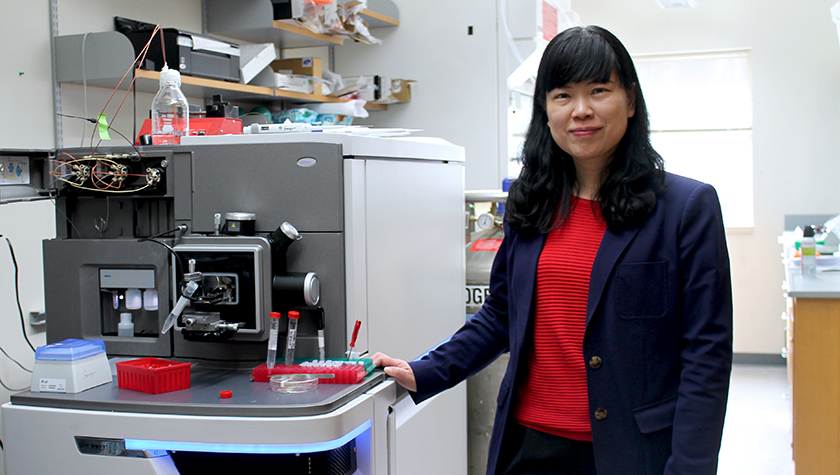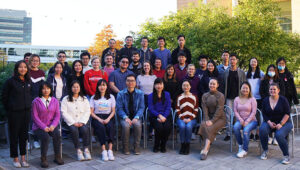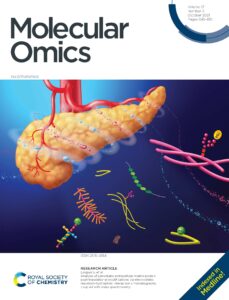
For the third year, School of Pharmacy Professor Lingjun Li is named one of the world’s most influential analytical scientists
By Nicole Etter
There are many ways to quantify University of Wisconsin–Madison School of Pharmacy Professor Lingjun Li’s career: Number of publications (300+ and counting). Number of times the Li Research Group’s work has been featured on a scientific journal cover (22). Number of novel neuropeptides discovered (300+). Number of graduate students who earned their PhD while working in Li’s lab (54).
However you measure it, Li’s impact on the field has been sizeable. It’s no wonder that The Analytical Scientist has named Li, the Charles Melbourne Johnson Distinguished Chair and the Vilas Distinguished Achievement Professor of Pharmaceutical Sciences and Chemistry, to its “Power List” of the world’s 100 most influential analytical scientists for the third time. In addition to 2021, Li was also selected for the list in 2019 and 2016, when the Power List featured the 50 Most Influential Women in Analytical Science.
The prolific researcher, who is also an associate editor for the Journal of The American Society for Mass Spectrometry, is known for her innovative work designing more efficient and precise tools for analytical science.
“Analytical science is really about meeting society’s needs,” she says. “We need to continue to innovate the technologies and methodologies and push the boundaries of our own discipline to meet those needs.”
Blending analytical chemistry and neuroscience
Li fell in love with the power of mass spectrometry during graduate school. She contemplated going into industry or taking a government job because she wasn’t sure she was cut out for a faculty position at an R1 research institution. Encouraged by her PhD advisor, she decided to go for it, and after a three-way postdoc, she found her home at UW–Madison.
“Initially I wouldn’t have imagined myself in a pharmacy school, but the UW–Madison School of Pharmacy has cultivated my professional development,” says Li. “One of the beauties of analytical science is it’s becoming more of a central science that can impact a lot of different areas of discovery and advancement via collaboration, which allows us to solve bigger problems. Being immersed in this very cross-disciplinary environment helps me to thrive.”
“One of the beauties of analytical science is it’s becoming more of a central science that can impact a lot of different areas of discovery and advancement via collaboration, which allows us to solve bigger problems.”
—Lingjun Li
When Li started her own lab at the School of Pharmacy in 2002, she decided to merge her interests in neuroscience and analytical chemistry by developing tools to better understand neuropeptides, a class of key chemical messengers in the brain. Because neuropeptides are present in low concentrations and can undergo rapid degradation, they can be difficult to detect.
“As an analytical chemist, I like to develop tools and methods that allow you to measure these interesting biomolecules with enough sensitivity,” Li explains. “We need to have a better understanding at a molecular level of these different molecules because if we don’t have a full description of all the molecular players involved in either our brain or neurocircuits, we’re not going to truly understand how they operate in health and disease.”
She began by analyzing neuropeptides in crustaceans, an ideal model to understand neuromodulation in a small neurocircuit that was later found to be important in humans.
“That same circuit can produce very different functions. If we switch from walking to running to swimming, muscle movement has to adjust, and all of these are controlled by the neurocircuit that is extensively modulated by this array of neurochemical messengers,” she explains. “This has implications for spinal cord injury. If you can restore these chemicals, you could potentially restore normal rhythmic activity.”

To zero in on the neuropeptides, Li and her team developed a multifaceted mass spectrometry platform and found more than 300 novel neuropeptides — far more than the 20 or so previously reported in a simple invertebrate system. Next she began to explore how the neuropeptides change in response to different environmental stressors, such as hypoxia (insufficient oxygen), neurodevelopmental conditions, copper toxicity and food intake.
Li’s team continues to push the limits of technology to make analytical tools more sensitive, higher throughput, and efficient.
“Neuropeptides can be very complex, and the same molecules might modulate differently depending on which brain regions have been activated,” she notes. That question spurred her to develop and adapt mass spectrometry imaging techniques.
Her lab also develops multiplexing quantitation strategies that involve creating a set of isotope-encoded chemical tags that can serve as barcodes for biological samples, enabling multiplexing up to 21 samples at once, while achieving quantitation and identification of biomolecules at the same time.
Pursuing new applications
The quest for better tools has expanded her work beyond neuropeptides and inspired collaborations with researchers who are interested in adopting her lab’s methods and tools.
“Since the methodology and technology is very versatile, it has allowed us to establish a lot of collaborations to look at a broader swath of biomedical problems, including diseases like Alzheimer’s disease and pancreatic cancer,” she says.
One ongoing project is focused on glycosylation, a process that modifies proteins, as a potential biomarker for Alzheimer’s disease.

“Most current biomarker studies are focused on proteins, but we believe that glycosylation changes might occur at earlier stages of the disease. Glycosylation pattern changes on a protein might be indicative of a disease state. During that process, we’ve developed a more effective enrichment strategy to pull these low-population glycans from cerebrospinal fluid to detect and pinpoint them,” she explains.
Another modification that the Li group is interested in studying is the switch of a single amino acid from the L-form to the D-form, which does not constitute a mass change, making it more challenging to study with conventional mass spec-based approaches. Li and her team developed another tool utilizing a special form of mass spec called ion mobility separation to allow them to distinguish minute changes in shape of a peptide containing a D-amino acid. D-amino acid-containing peptides have been implicated as biomarkers of several diseases and aging, and importantly, they reveal potential pharmaceutical targets.
“If you have the right amino acid sequence but the wrong chirality, it might not have the right biological effect,” she says.
She is also excited about the potential of single-cell multi-omics analysis to create a molecular atlas of the brain, which could be useful for discovering new biomarkers for diseases like Alzheimer’s and Parkinson’s.
The single-cell multi-omics approaches will also lead to better understanding of tumor heterogeneity, tumor microenvironment and chemotherapy resistance in cancer. To that end, the Li group is also applying mass spectrometry imaging technology to study three-dimensional cell cultures of pancreatic cancer. “With a mass spectrometry imaging technique and a 3-D cell culture model, we can evaluate these drug compounds to see where these drugs are delivered in the tumor. This would help us better understand how these different chemicals are delivered or distributed,” she explains.
Long-lasting impact
While Li’s years in the lab have been fruitful, she doesn’t measure her success solely by scientific breakthroughs. She’s most proud of the dozens of talented graduate students who have worked in her lab, and she credits their enthusiasm and curiosity for expanding her research into areas she might not have otherwise explored.
Two-thirds of her PhD graduates have joined the pharmaceutical industry, many working at top pharma companies, while the remaining third have joined academia, where some are now mentoring the next generation of graduate students. Li has remained in touch with them all.
“When I started this position, I thought, ‘I’ll do great science and publish papers,’ but I think the most rewarding aspect of this job has been the ability to work with and influence a new generation of scientists and to watch them grow professionally and become independent scientists who are pursuing their own research goals,” she says. “That is long-lasting impact.”